Project Execution Control - Doc
VerifiedAdded on 2021/06/17
|7
|1600
|59
AI Summary
Contribute Materials
Your contribution can guide someone’s learning journey. Share your
documents today.
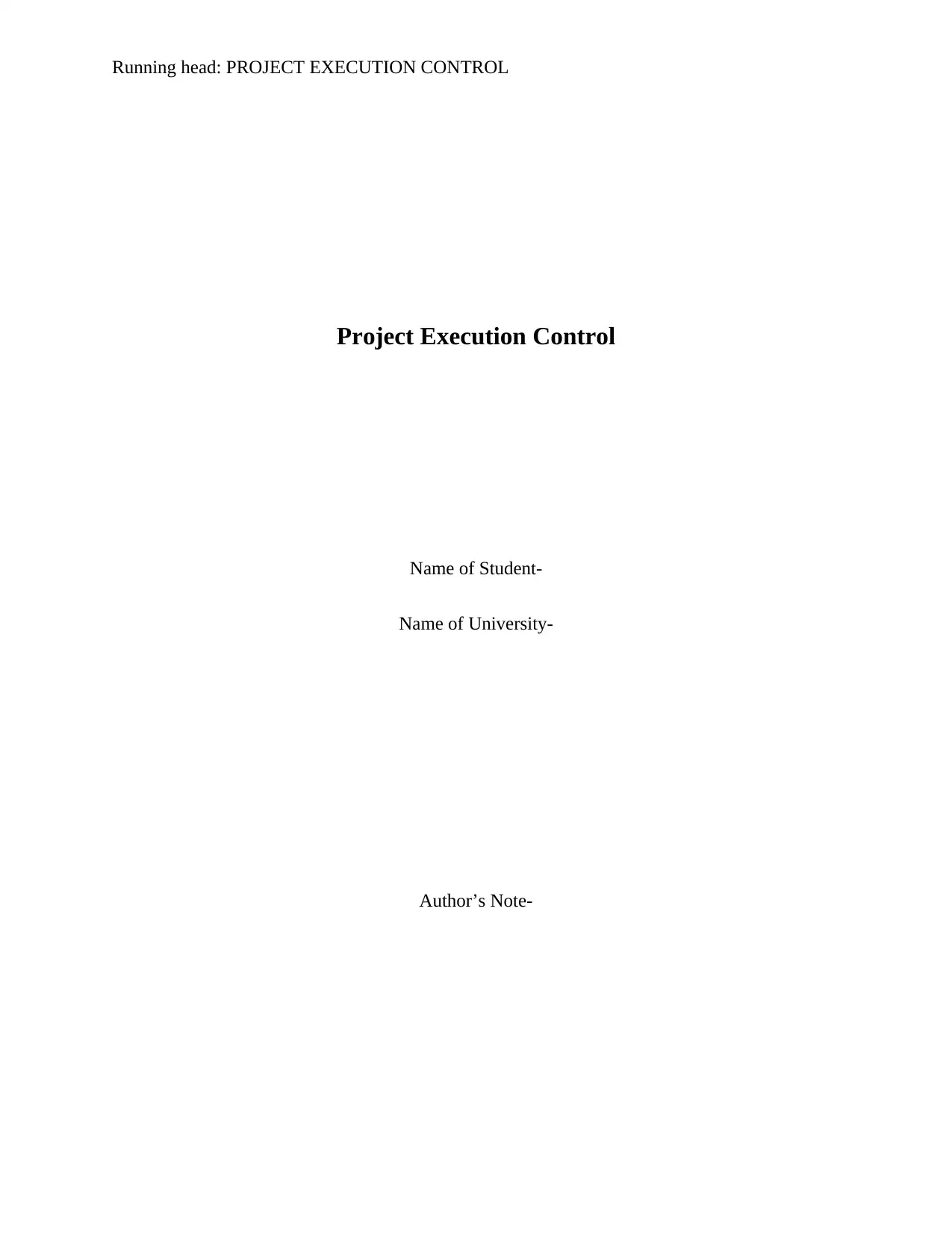
Running head: PROJECT EXECUTION CONTROL
Project Execution Control
Name of Student-
Name of University-
Author’s Note-
Project Execution Control
Name of Student-
Name of University-
Author’s Note-
Secure Best Marks with AI Grader
Need help grading? Try our AI Grader for instant feedback on your assignments.
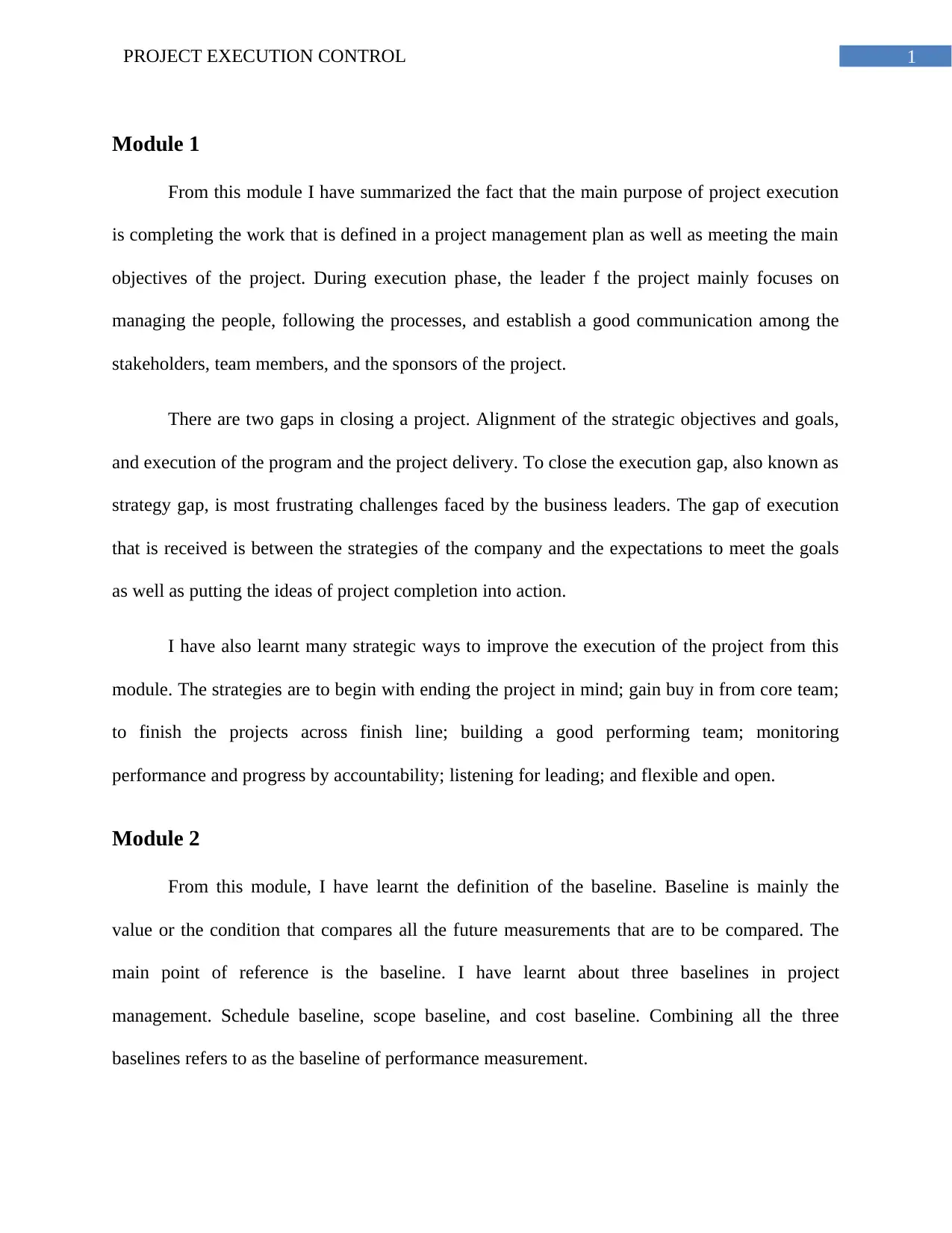
1PROJECT EXECUTION CONTROL
Module 1
From this module I have summarized the fact that the main purpose of project execution
is completing the work that is defined in a project management plan as well as meeting the main
objectives of the project. During execution phase, the leader f the project mainly focuses on
managing the people, following the processes, and establish a good communication among the
stakeholders, team members, and the sponsors of the project.
There are two gaps in closing a project. Alignment of the strategic objectives and goals,
and execution of the program and the project delivery. To close the execution gap, also known as
strategy gap, is most frustrating challenges faced by the business leaders. The gap of execution
that is received is between the strategies of the company and the expectations to meet the goals
as well as putting the ideas of project completion into action.
I have also learnt many strategic ways to improve the execution of the project from this
module. The strategies are to begin with ending the project in mind; gain buy in from core team;
to finish the projects across finish line; building a good performing team; monitoring
performance and progress by accountability; listening for leading; and flexible and open.
Module 2
From this module, I have learnt the definition of the baseline. Baseline is mainly the
value or the condition that compares all the future measurements that are to be compared. The
main point of reference is the baseline. I have learnt about three baselines in project
management. Schedule baseline, scope baseline, and cost baseline. Combining all the three
baselines refers to as the baseline of performance measurement.
Module 1
From this module I have summarized the fact that the main purpose of project execution
is completing the work that is defined in a project management plan as well as meeting the main
objectives of the project. During execution phase, the leader f the project mainly focuses on
managing the people, following the processes, and establish a good communication among the
stakeholders, team members, and the sponsors of the project.
There are two gaps in closing a project. Alignment of the strategic objectives and goals,
and execution of the program and the project delivery. To close the execution gap, also known as
strategy gap, is most frustrating challenges faced by the business leaders. The gap of execution
that is received is between the strategies of the company and the expectations to meet the goals
as well as putting the ideas of project completion into action.
I have also learnt many strategic ways to improve the execution of the project from this
module. The strategies are to begin with ending the project in mind; gain buy in from core team;
to finish the projects across finish line; building a good performing team; monitoring
performance and progress by accountability; listening for leading; and flexible and open.
Module 2
From this module, I have learnt the definition of the baseline. Baseline is mainly the
value or the condition that compares all the future measurements that are to be compared. The
main point of reference is the baseline. I have learnt about three baselines in project
management. Schedule baseline, scope baseline, and cost baseline. Combining all the three
baselines refers to as the baseline of performance measurement.

2PROJECT EXECUTION CONTROL
This module also defines project control as the gathering of data, analytical processes that
are used to predict a project, management of data, and influence of cost and time of the outcome
of program or project. These can be done through communication of the information of time and
cost results of a program or a project that are done by decision making or effective management.
There are three project control strategies that is with respect of time, scope, and cost.
Time should be controlled by the managers of a project because to finish the project in time
should be the main aim of project. Cost should be controlled and managed as while dealing with
a project, the cost goes on changing. There should also be a scope of the project that deal with
delivering the project with all requirements.
Module 3
This module states many difference between standards and regulations. Both have
different implications for trading internationally. When a product is imported, if it does not
fulfills all the requirements related to technical regulation, the product will not be sold in the
market. Standards are the product quality that are to be maintained while regulation involves
marinating al the standards of the government in which the product is sold.
There are tools and techniques involved in project management. The tools as well as
techniques that are related with project involves the projects that makes the project much easy
and effective. The managers, software of project management, and there are different aspects in
project management that carries their toolbox with them that includes an array of useful
apparatus helping the project to save the time and the cost. Planning tools and techniques that are
involved in project management includes PERT, CPM, KANBAN, Gantt chart.
This module also defines project control as the gathering of data, analytical processes that
are used to predict a project, management of data, and influence of cost and time of the outcome
of program or project. These can be done through communication of the information of time and
cost results of a program or a project that are done by decision making or effective management.
There are three project control strategies that is with respect of time, scope, and cost.
Time should be controlled by the managers of a project because to finish the project in time
should be the main aim of project. Cost should be controlled and managed as while dealing with
a project, the cost goes on changing. There should also be a scope of the project that deal with
delivering the project with all requirements.
Module 3
This module states many difference between standards and regulations. Both have
different implications for trading internationally. When a product is imported, if it does not
fulfills all the requirements related to technical regulation, the product will not be sold in the
market. Standards are the product quality that are to be maintained while regulation involves
marinating al the standards of the government in which the product is sold.
There are tools and techniques involved in project management. The tools as well as
techniques that are related with project involves the projects that makes the project much easy
and effective. The managers, software of project management, and there are different aspects in
project management that carries their toolbox with them that includes an array of useful
apparatus helping the project to save the time and the cost. Planning tools and techniques that are
involved in project management includes PERT, CPM, KANBAN, Gantt chart.
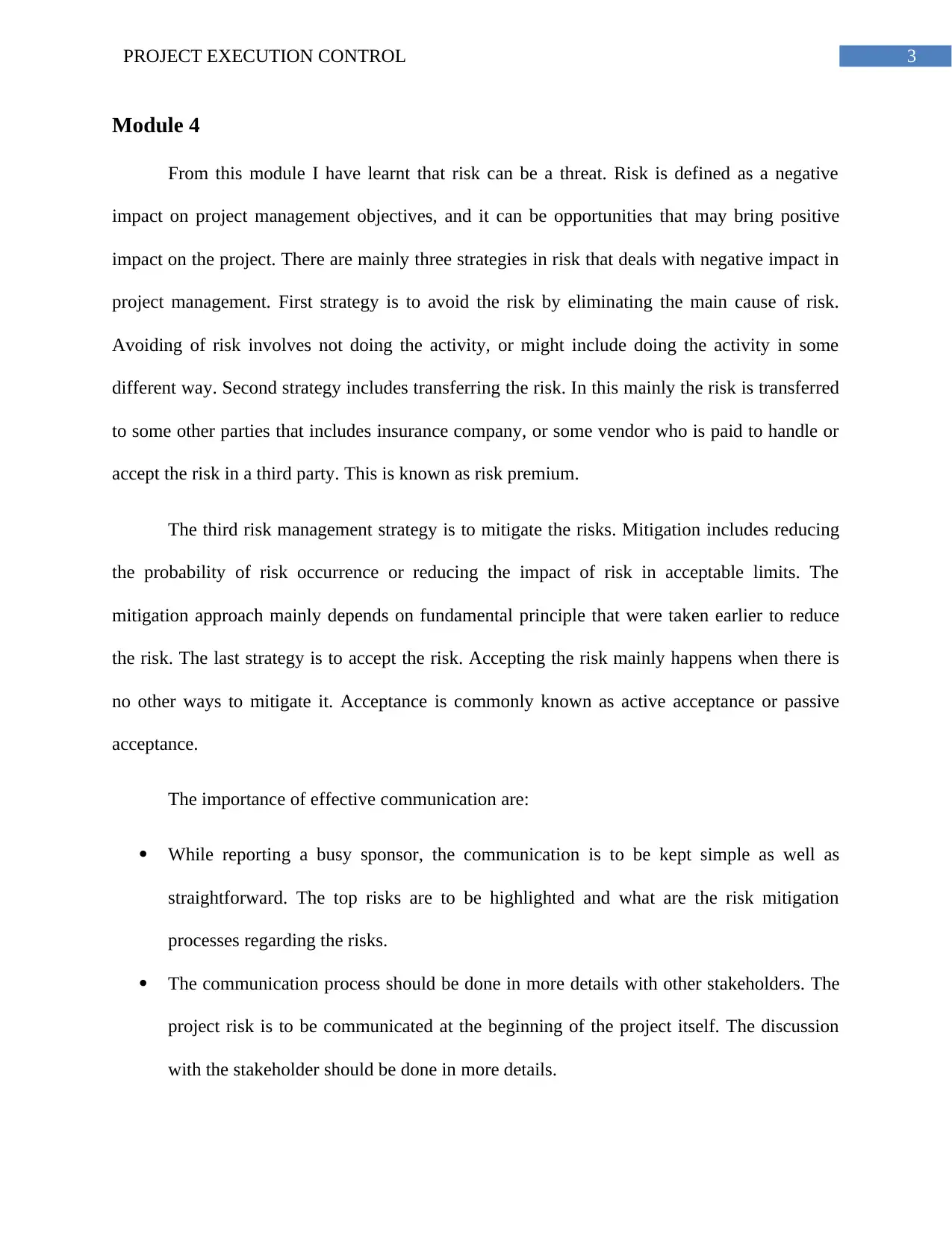
3PROJECT EXECUTION CONTROL
Module 4
From this module I have learnt that risk can be a threat. Risk is defined as a negative
impact on project management objectives, and it can be opportunities that may bring positive
impact on the project. There are mainly three strategies in risk that deals with negative impact in
project management. First strategy is to avoid the risk by eliminating the main cause of risk.
Avoiding of risk involves not doing the activity, or might include doing the activity in some
different way. Second strategy includes transferring the risk. In this mainly the risk is transferred
to some other parties that includes insurance company, or some vendor who is paid to handle or
accept the risk in a third party. This is known as risk premium.
The third risk management strategy is to mitigate the risks. Mitigation includes reducing
the probability of risk occurrence or reducing the impact of risk in acceptable limits. The
mitigation approach mainly depends on fundamental principle that were taken earlier to reduce
the risk. The last strategy is to accept the risk. Accepting the risk mainly happens when there is
no other ways to mitigate it. Acceptance is commonly known as active acceptance or passive
acceptance.
The importance of effective communication are:
While reporting a busy sponsor, the communication is to be kept simple as well as
straightforward. The top risks are to be highlighted and what are the risk mitigation
processes regarding the risks.
The communication process should be done in more details with other stakeholders. The
project risk is to be communicated at the beginning of the project itself. The discussion
with the stakeholder should be done in more details.
Module 4
From this module I have learnt that risk can be a threat. Risk is defined as a negative
impact on project management objectives, and it can be opportunities that may bring positive
impact on the project. There are mainly three strategies in risk that deals with negative impact in
project management. First strategy is to avoid the risk by eliminating the main cause of risk.
Avoiding of risk involves not doing the activity, or might include doing the activity in some
different way. Second strategy includes transferring the risk. In this mainly the risk is transferred
to some other parties that includes insurance company, or some vendor who is paid to handle or
accept the risk in a third party. This is known as risk premium.
The third risk management strategy is to mitigate the risks. Mitigation includes reducing
the probability of risk occurrence or reducing the impact of risk in acceptable limits. The
mitigation approach mainly depends on fundamental principle that were taken earlier to reduce
the risk. The last strategy is to accept the risk. Accepting the risk mainly happens when there is
no other ways to mitigate it. Acceptance is commonly known as active acceptance or passive
acceptance.
The importance of effective communication are:
While reporting a busy sponsor, the communication is to be kept simple as well as
straightforward. The top risks are to be highlighted and what are the risk mitigation
processes regarding the risks.
The communication process should be done in more details with other stakeholders. The
project risk is to be communicated at the beginning of the project itself. The discussion
with the stakeholder should be done in more details.
Secure Best Marks with AI Grader
Need help grading? Try our AI Grader for instant feedback on your assignments.
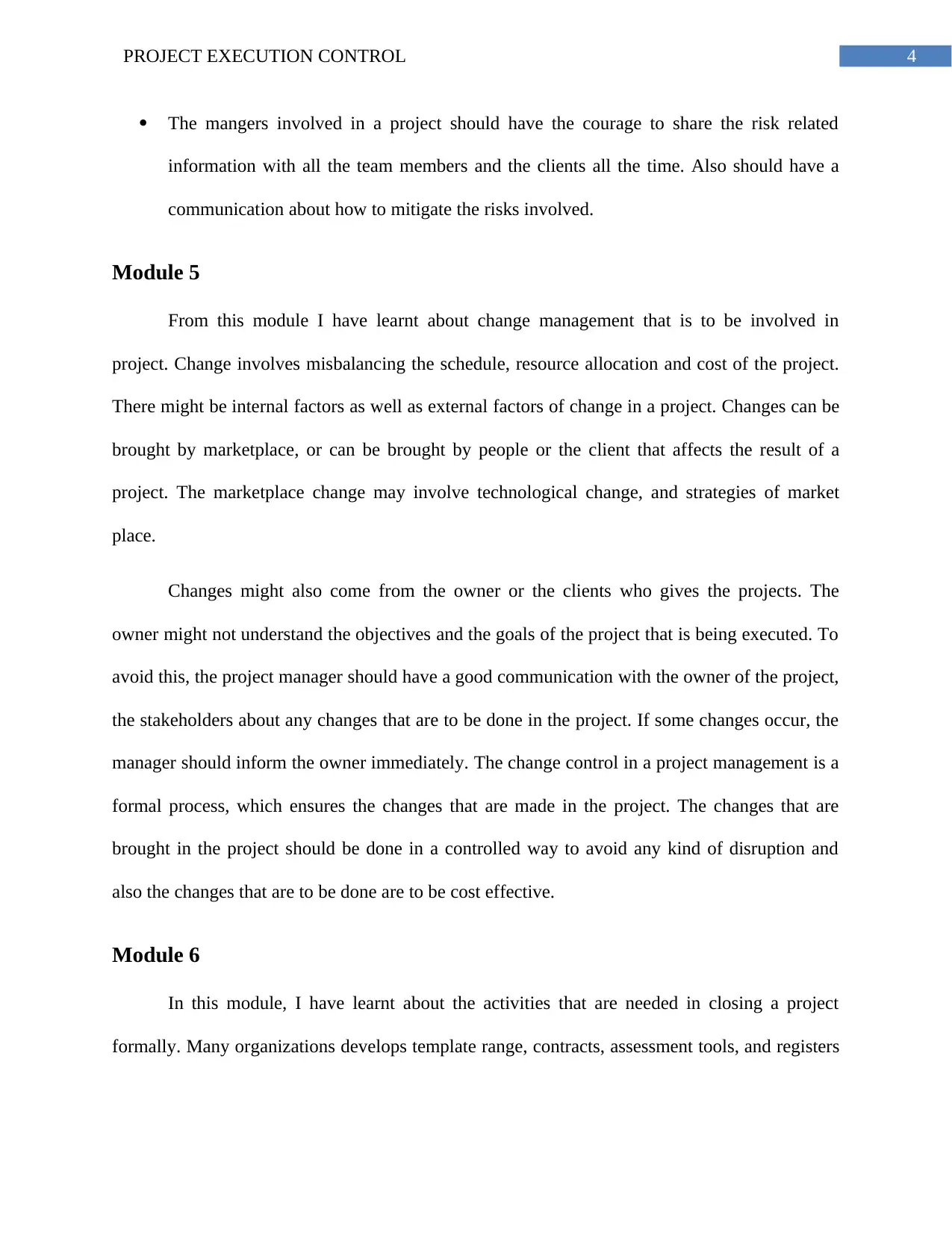
4PROJECT EXECUTION CONTROL
The mangers involved in a project should have the courage to share the risk related
information with all the team members and the clients all the time. Also should have a
communication about how to mitigate the risks involved.
Module 5
From this module I have learnt about change management that is to be involved in
project. Change involves misbalancing the schedule, resource allocation and cost of the project.
There might be internal factors as well as external factors of change in a project. Changes can be
brought by marketplace, or can be brought by people or the client that affects the result of a
project. The marketplace change may involve technological change, and strategies of market
place.
Changes might also come from the owner or the clients who gives the projects. The
owner might not understand the objectives and the goals of the project that is being executed. To
avoid this, the project manager should have a good communication with the owner of the project,
the stakeholders about any changes that are to be done in the project. If some changes occur, the
manager should inform the owner immediately. The change control in a project management is a
formal process, which ensures the changes that are made in the project. The changes that are
brought in the project should be done in a controlled way to avoid any kind of disruption and
also the changes that are to be done are to be cost effective.
Module 6
In this module, I have learnt about the activities that are needed in closing a project
formally. Many organizations develops template range, contracts, assessment tools, and registers
The mangers involved in a project should have the courage to share the risk related
information with all the team members and the clients all the time. Also should have a
communication about how to mitigate the risks involved.
Module 5
From this module I have learnt about change management that is to be involved in
project. Change involves misbalancing the schedule, resource allocation and cost of the project.
There might be internal factors as well as external factors of change in a project. Changes can be
brought by marketplace, or can be brought by people or the client that affects the result of a
project. The marketplace change may involve technological change, and strategies of market
place.
Changes might also come from the owner or the clients who gives the projects. The
owner might not understand the objectives and the goals of the project that is being executed. To
avoid this, the project manager should have a good communication with the owner of the project,
the stakeholders about any changes that are to be done in the project. If some changes occur, the
manager should inform the owner immediately. The change control in a project management is a
formal process, which ensures the changes that are made in the project. The changes that are
brought in the project should be done in a controlled way to avoid any kind of disruption and
also the changes that are to be done are to be cost effective.
Module 6
In this module, I have learnt about the activities that are needed in closing a project
formally. Many organizations develops template range, contracts, assessment tools, and registers
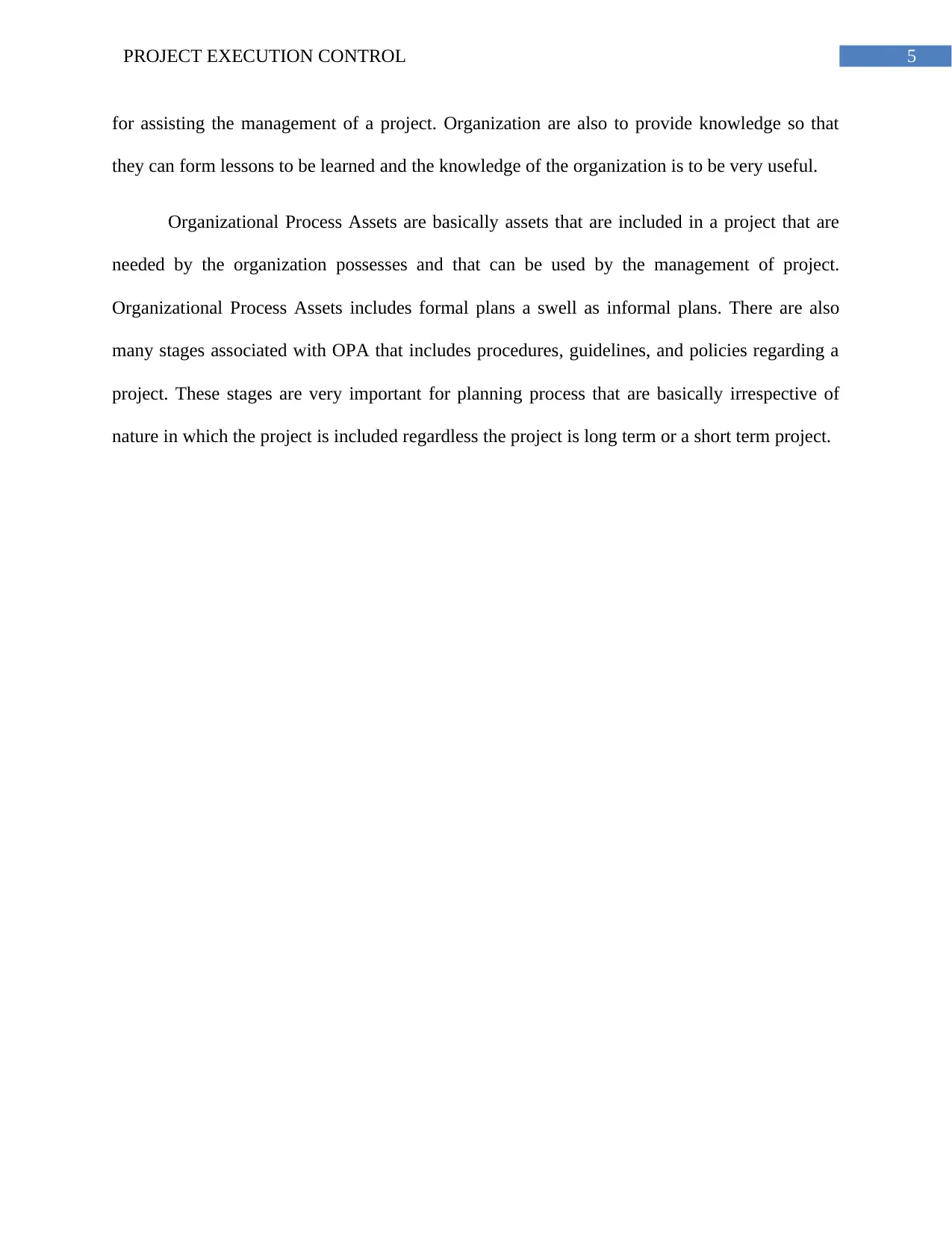
5PROJECT EXECUTION CONTROL
for assisting the management of a project. Organization are also to provide knowledge so that
they can form lessons to be learned and the knowledge of the organization is to be very useful.
Organizational Process Assets are basically assets that are included in a project that are
needed by the organization possesses and that can be used by the management of project.
Organizational Process Assets includes formal plans a swell as informal plans. There are also
many stages associated with OPA that includes procedures, guidelines, and policies regarding a
project. These stages are very important for planning process that are basically irrespective of
nature in which the project is included regardless the project is long term or a short term project.
for assisting the management of a project. Organization are also to provide knowledge so that
they can form lessons to be learned and the knowledge of the organization is to be very useful.
Organizational Process Assets are basically assets that are included in a project that are
needed by the organization possesses and that can be used by the management of project.
Organizational Process Assets includes formal plans a swell as informal plans. There are also
many stages associated with OPA that includes procedures, guidelines, and policies regarding a
project. These stages are very important for planning process that are basically irrespective of
nature in which the project is included regardless the project is long term or a short term project.
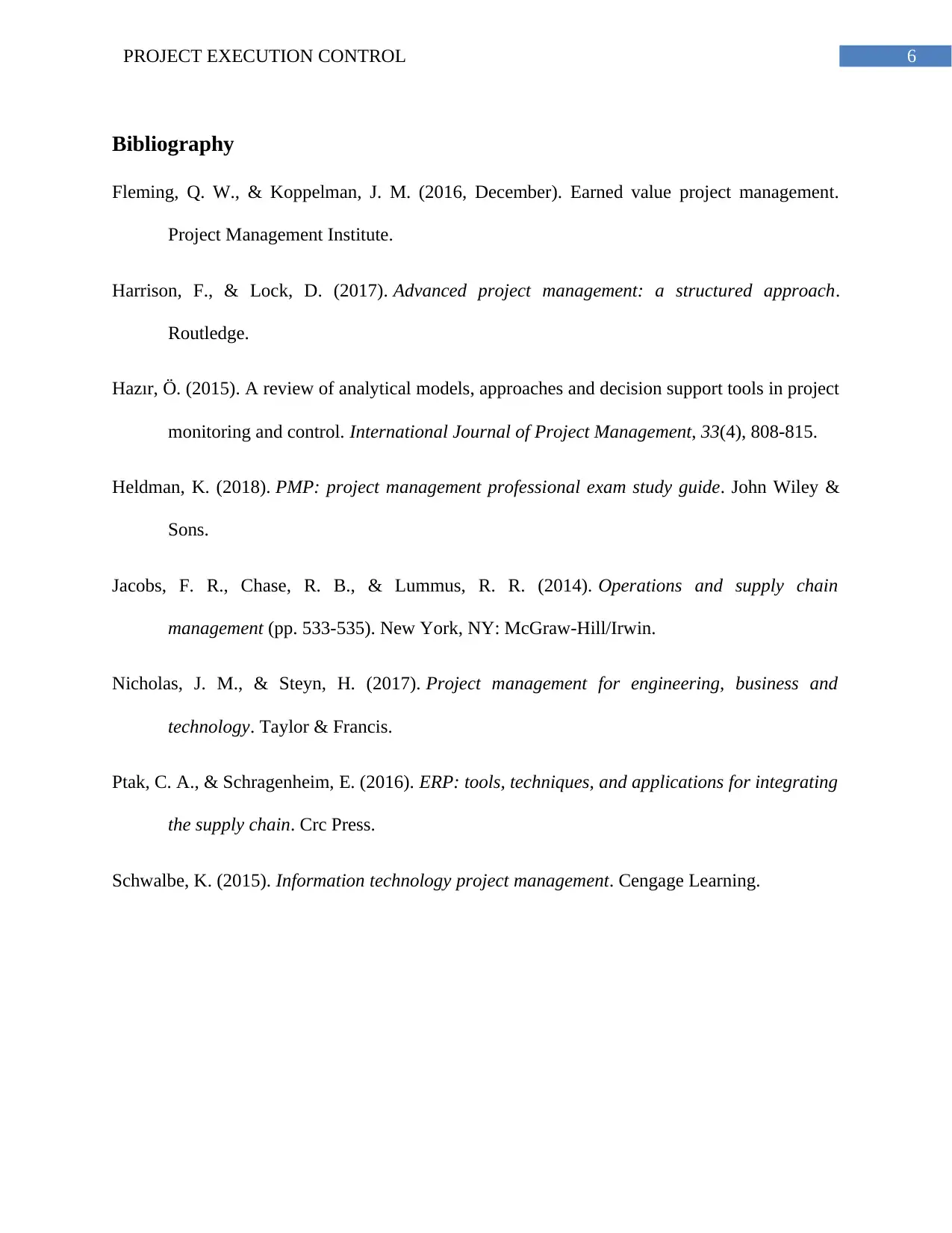
6PROJECT EXECUTION CONTROL
Bibliography
Fleming, Q. W., & Koppelman, J. M. (2016, December). Earned value project management.
Project Management Institute.
Harrison, F., & Lock, D. (2017). Advanced project management: a structured approach.
Routledge.
Hazır, Ö. (2015). A review of analytical models, approaches and decision support tools in project
monitoring and control. International Journal of Project Management, 33(4), 808-815.
Heldman, K. (2018). PMP: project management professional exam study guide. John Wiley &
Sons.
Jacobs, F. R., Chase, R. B., & Lummus, R. R. (2014). Operations and supply chain
management (pp. 533-535). New York, NY: McGraw-Hill/Irwin.
Nicholas, J. M., & Steyn, H. (2017). Project management for engineering, business and
technology. Taylor & Francis.
Ptak, C. A., & Schragenheim, E. (2016). ERP: tools, techniques, and applications for integrating
the supply chain. Crc Press.
Schwalbe, K. (2015). Information technology project management. Cengage Learning.
Bibliography
Fleming, Q. W., & Koppelman, J. M. (2016, December). Earned value project management.
Project Management Institute.
Harrison, F., & Lock, D. (2017). Advanced project management: a structured approach.
Routledge.
Hazır, Ö. (2015). A review of analytical models, approaches and decision support tools in project
monitoring and control. International Journal of Project Management, 33(4), 808-815.
Heldman, K. (2018). PMP: project management professional exam study guide. John Wiley &
Sons.
Jacobs, F. R., Chase, R. B., & Lummus, R. R. (2014). Operations and supply chain
management (pp. 533-535). New York, NY: McGraw-Hill/Irwin.
Nicholas, J. M., & Steyn, H. (2017). Project management for engineering, business and
technology. Taylor & Francis.
Ptak, C. A., & Schragenheim, E. (2016). ERP: tools, techniques, and applications for integrating
the supply chain. Crc Press.
Schwalbe, K. (2015). Information technology project management. Cengage Learning.
1 out of 7
![[object Object]](/_next/static/media/star-bottom.7253800d.svg)





